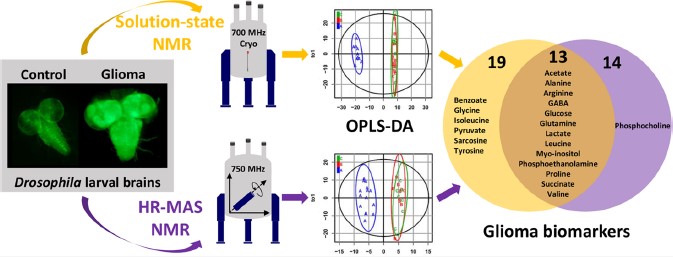Ask for a reprint
email :
* Give your email
2021
ACL
|
Marion Maravat, Marylène Bertrand, Céline Landon, Franck Fayon, Séverine Morisset-Lopez, Vincent Sarou-Kanian, Martine Decoville, 'Complementary Nuclear Magnetic Resonance-Based Metabolomics Approaches for Glioma Biomarker Identification in a Drosophila melanogaster Model', J. Proteome Res. 20 3977–3991 (2021) doi:10.1021/acs.jproteome.1c00304
Human malignant gliomas are the most common type of primary brain tumor. Composed of glial cells and their precursors, they are aggressive and highly invasive, leading to a poor prognosis. Due to the difficulty of surgically removing tumors and their resistance to treatments, novel therapeutic approaches are needed to improve patient life expectancy and comfort. Drosophila melanogaster is a compelling genetic model to better understanding human neurological diseases owing to its high conservation in signaling pathways and cellular content of the brain. Here, glioma has been induced in Drosophila by co-activating the epidermal growth factor receptor and the phosphatidyl-inositol-3 kinase signaling pathways. Complementary nuclear magnetic resonance (NMR) techniques were used to obtain metabolic profiles in the third instar larvae brains. Fresh organs were directly studied by 1H high resolution-magic angle spinning (HR-MAS) NMR, and brain extracts were analyzed by solution-state 1H-NMR. Statistical analyses revealed differential metabolic signatures, impacted metabolic pathways, and glioma biomarkers. Each method was efficient to determine biomarkers. The highlighted metabolites including glucose, myo-inositol, sarcosine, glycine, alanine, and pyruvate for solution-state NMR and proline, myo-inositol, acetate, and glucose for HR-MAS show very good performances in discriminating samples according to their nature with data mining based on receiver operating characteristic curves. Combining results allows for a more complete view of induced disturbances and opens the possibility of deciphering the biochemical mechanisms of these tumors. The identified biomarkers provide a means to rebalance specific pathways through targeted metabolic therapy and to study the effects of pharmacological treatments using Drosophila as a model organism.
|

|